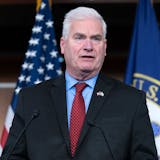The Minneapolis 2040 plan is considered a sweeping policy manifesto of what the future of housing, transportation, arts and culture, and racial equity should look like in Minnesota's largest city.
Minneapolis City Council members voted last month to move forward on the plan after getting approval from the Metropolitan Council, the planning agency responsible for overseeing its implementation. While the 2040 plan goes into effect Jan. 1, the council is still putting into place many of its elements.
Here are some of the major things to watch:
Duplexes/triplexes
This provision of the 2040 plan has garnered national attention for eliminating single-family zoning to allow duplexes and triplexes.
Council President Lisa Bender said the policy change is "a big shift philosophically" but she does not expect duplex and triplex conversions to pop up in neighborhoods right away. Costs and the building size constraints will be a likely barrier for many property owners. But she said the city is anticipating seeing these changes in existing older homes around the city.
"I think this change will help increase the housing options in all neighborhoods," Bender said. "I think it will get us to a place where illegal units are becoming legalized and therefore licensed and inspected, which is a good thing because we want people in safe and licensed housing."
Timeline: Expected to go into effect Jan. 1., after final approval this week.
Inclusionary zoning
City Council members are following guidance from a consulting firm that Minneapolis should require developers to set aside 10% to 20% of new units for lower-income tenants. The council sees it as a way to add to the affordable housing stock in Minneapolis and would follow similar policies in Bloomington, Brooklyn Park, Golden Valley, Edina and St. Louis Park.



